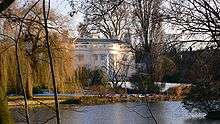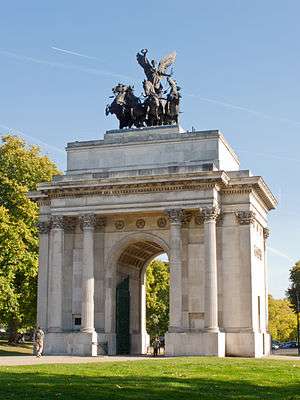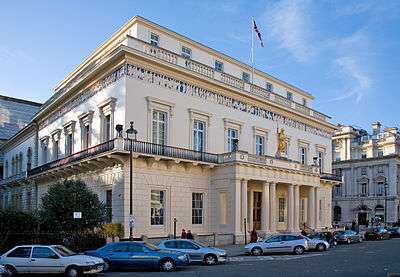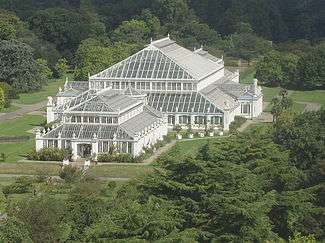Decimus Burton
| Decimus Burton FRS FRSA FSA FRIBA | |
|---|---|
 Decimus Burton by Thomas Lawrence | |
| Born |
30 September 1800 North House, Southampton Terrace, Bloomsbury, London |
| Died |
14 December 1881 1 Gloucester Houses, Kensington, London. |
| Resting place | Kensal Green Cemetery, London. |
| Nationality | British |
| Education | Tonbridge School |
| Alma mater | Royal Academy |
| Occupation | Architect |
| Notable work | Hyde Park, London Gate/Screen, Wellington Arch, Athenaeum Club, London, Royal Botanic Gardens, Kew, Cornwall Terrace, Chester Terrace, London Zoo, Carlton House Terrace, Fleetwood, St Leonards-on-Sea, Tunbridge Wells. |
| Parents |
|
| Relatives | James Burton (Egyptologist) (Brother) |
Decimus Burton FRS FRSA FSA FRIBA (30 September 1800 – 14 December 1881) was one of the foremost English architects of the 19th century. He was a leading exponent of the Greek revival, Georgian and Regency styles.
He was the son of property developer James Burton and brother of Egyptologist James Burton.
His works include Hyde Park, London, including Gate/Screen at Hyde Park Corner and the Wellington Arch, London Zoo, the Royal Botanic Gardens, Kew, the clubhouse of the Athenaeum Club, London, Regent's Park, London, including Cornwall Terrace, Chester Terrace, and the villas of the Inner Circle (including his own residence, The Holme), Green Park, London, Carlton House Terrace, and the layout and architecture of the seaside towns of Fleetwood and St Leonards-on-Sea and the spa town Tunbridge Wells. He also worked on Buckingham Palace, where he was responsible for the removal of Nash's Marble Arch facing the building to its present site and the subsequent enclosure of the forecourt.
Family
Decimus was the 10th child of the property developer James Burton (formerly James Haliburton)[1] and Elizabeth Westley (12 December 1761 – 14 January 1837), of Loughton, Essex, daughter of John and Mary Westley. He was a brother of Egyptologist James Burton.
On his father's side, his great-great grandparents were Rev. James Haliburton (1681–1756) and Margaret Eliott, daughter of Sir William Eliott, 2nd Baronet and aunt of George Augustus Eliott, 1st Baron Heathfield. Decimus was descended from John Haliburton (1573–1627), from whom Sir Walter Scott, 1st Baronet could trace his descent on the maternal side. He was a cousin of the American judge and author Thomas Chandler Haliburton and thence of the lawyer and anthropologist Robert Grant Haliburton and Arthur Lawrence Haliburton, 1st Baron Haliburton.[2]
Education
Decimus left Tonbridge School in 1816. Due to his father's social standing, he was able to enter the Royal Academy Schools directly, in 1817, without having been articled to an architect. Here he was taught by Sir John Soane, for whom his brother, James, had also worked. Decimus then trained with his father, during which time he receive drawing lessons from George Maddox (architect).[3]
Style
Decimus was exceptionally learned, as the diversity of his library, part of which was auctioned by his nieces, revealed. The sale catalogue listed 347 separate lots, some of which ran into many volumes. The collection indicates a range of interests beyond architectural theory and practice: it contained the Proceedings of the Camden Society complete in 135 volumes and transactions of many of the learned societies of which Burton was a member as well as a complete set of the Histoire Naturelle (70 vols.) of G. L. L. Buffon and Bernard Germain de Lacépède. The architectural texts comprised mostly standard works on classical architecture, such as the five volumes of Colen Campbell, Vitruvius Britannicus by John Woolfe and James Gandon, James Gibbs's Book of Architecture, and William Kent's The Designs of Inigo Jones. Alongside these, topographical views and surveys of cities and counties pepper the collection. There were also some foreign-language texts, including volumes by Charles Percier and Jean-Baptiste Rondelet, a complete set of Giovanni Battista Piranesi's works, and several dictionaries. Although Burton travelled to France and Spain, about which journey little is known, the absence of an educative grand tour early in his career meant that his books and casts were his sources for design. This goes some way towards explaining the formal academic character of his architecture.[3]
Decimus was a leading exponent of the Greek revival style of architecture, although, uniquely, he was also significantly influenced by the styles of Ancient Rome. In his later career, he designed some buildings in the Gothic revival style, the ‘old English’ style, and the cottage orné style.[3]
Decimus was one of the first architects to consider the implications of architecture on the creation of distinct urban environments in which they featured. Evidence given by Burton to two parliamentary select committees shows the diversity of his experience and, by virtue of his being asked, the esteem in which his opinion was held by contemporaries. Burton's evidence to the select committee of the House of Commons (1840), which discussed plans to develop Trafalgar Square, gave a more public platform to his views on urban planning.[4] This is one of the first examples of public discussion about an urban space with acknowledged national and political significance.[3]
Relationship with John Nash
Decimus came into contact with John Nash via his father, who was responsible for building many of Nash's London designs. Nash was appointed architectural 'overseer' for Decimus's Regent's Park projects: Cornwall Terrace, York Terrace, Chester Terrace and the villas of the Inner Circle, including The Holme. However, to the chagrin of Nash, Decimus largely disregarded his advice and developed the Terraces according his own style, to the extent that Nash sought the demolition and complete rebuilding of Chester Terrace, but in vain.[3][2] Decimus also emerged as the dominant force in the design of Carlton House Terrace.
Personal life
In 1832 Decimus Burton was elected a Fellow of the Royal Society.[1] He was also a Fellow of the Royal Society of Arts,[3] a Fellow of the Society of Antiquaries of London.,[5] a founding Fellow and later Vice-President of the Royal Institute of British Architects and architect to the Royal Botanic Society from 1840.[6]
Decimus was a founding member of the Athenaeum Club, London, whose clubhouse he designed. His father was also a founding member.[7][8]
Decimus taught the architects Henry Currey (architect) FRIBA, E.J. May FRIBA, and Henry Marley Burton FRIBA,[6] the eldest illegitimate son of his eldest brother William.
Decimus retired in 1869 and died in December 1881. He never married and died without issue, leaving his estate to his family. He is buried in Kensal Green Cemetery.
List of architectural works
(Listed by county in alphabetical order)[9]
Buckinghamshire
- Stockgrove House, Buckinghamshire/Bedfordshire border (1831) demolished circa 1928
Derbyshire
- The Great Conservatory at Chatsworth with Joseph Paxton (1836–1840) demolished circa 1920
- Great Conservatory, Chatsworth House, with Joseph Paxton
Dorset
- Lower Pleasure Gardens, Bournemouth (1840s)
- St Mary’s church, Bradford Peverell (1850)
East Sussex
- Oaklands Park, Sedlescombe (1830)
- Adelaide Crescent, Hove (1831) (only numbers 1–10 were built, the remainder were completed from 1850 to a much grander design)
%2C_Hove_(IoE_Code_365479).jpg) Adelaide Crescent, Hove, Brighton, Burton's houses are on the left.
Adelaide Crescent, Hove, Brighton, Burton's houses are on the left.
- Wick Hall, Hove (1840; demolished 1936)
- Holy Trinity Church, Eastbourne (1837-9; later extended)
- St. Augustine's Church, Flimwell (1839)
St Leonards-on-Sea
In 1828 Burton's father James bought up an estate in East Sussex, on which he built the new town of St Leonard's-on-Sea as a pleasure resort for the aristocracy. Decimus designed the majority of the buildings.[10]
Greater London
Regent's Park
- The Holme, Inner Circle, Regent’s Park (1818), Residence of the Burton family including Decimus's father, James Burton who built it. Architectural critic Ian Nairn wrote of the house, "If you want a definition of western civilization in a single view, then here it is".
- Grove House, Holford House and Winfield House, South Villa (1819), the Marquess of Hertford's villa (designs exh. RA, 1822, 1825; MS book of drawings of the villa now in the Architectural Association Library, London); Grove House, Hanover Lodge, Holford House (1833). St John's Lodge, owned by John Mabberley MP, was let in 1829 to Marquess Wellesley, who employed Burton to enlarge it.
- London Colosseum, Regents Park (1823–27). Circular in plan with a Doric portico,it resembled the Pantheon in form.[11] It was demolished in 1875; the site is now occupied by the Royal College of Physicians.
- Clarence Terrace, Regent's Park (1823)
- Cornwall Terrace, Regent's Park, London (1827)
- Chester Terrace, Regent's Park, London.
- Zoological Society Gardens (1826–41)
- Botanical Society Gardens (1840–59).

 The Holme, Regent's Park
The Holme, Regent's Park
 London Zoo c.1854
London Zoo c.1854
Hyde Park
Burton's work at Hyde Park, Green Park, and St James's Park begun in 1825, shows him to be one of the main executants of the vision of George IV and his ministers of London as a royal city rivalling its European counterparts. In collaboration with the king and his chief officials, Burton planned to create an urban space dedicated to the celebration of the House of Hanover, national pride, and the nation's heroes.
The project, which evolved in the 1820s, comprised creating two aligned entrances, the Wellington Arch at Constitution Hill into Green Park, London and the Hyde Park Gate/Screen at Hyde Park Corner. These two entrances would form part of a processional route for the monarch from Buckingham Palace to Hyde Park. The arch at Constitution Hill was left devoid of decorative sculpture as a result of the moratorium in 1828 on public building work, and was used instead, much to Burton's chagrin, as a plinth for an oversized and much ridiculed equestrian statue of the Duke of Wellington by Matthew Cotes Wyatt, which was later removed to Aldershot. In 1883 the arch at Constitution Hill was turned and resited to make way for increased traffic, and Burton's two aligned entrances were thus knocked off their axis.
Burton also laid out the paths and driveways and lodges of the Parks. He made new designs for the Stanhope, Grosvenor, and Cumberland gates. More ambitious plans for the parks that were not realized include the dramatic circular Bayswater Gate and Lodge and an entrance to Green Park from Piccadilly based on a Greek temple design.
 Wellington Arch, Hyde Park Corner
Wellington Arch, Hyde Park Corner Screen, Hyde Park Corner
Screen, Hyde Park Corner
Other London Works
- Parliamentary Stables, Westminster
- London Zoo, various buildings (1826–28) and (1831–34); surviving buildings include the Giraffe House, the Camel House, the Raven Cage and the tunnel under the Outer Circle, connecting the two parts of the zoo. He also designed the llama building (1828) with a clock tower.
- Carlton House Terrace (with John Nash)
- The Geological Society's apartments at Somerset House (1828)
- Athenaeum, Pall Mall (1828–30). The exterior is decorated with a full-size replica of the Panathenaic frieze. Burton later made alterations to the United Service Club. Burton's became a member of the club and had 30 years of correspondence with one of the club's founders, John Wilson Croker.[8]
- Charing Cross Hospital, London (1831–9)
- Putney Park House, Roehampton, London (1837–38)[12]
- Devonshire House, London, added portico and remodelled the hall and staircase (1843) demolished
- The library at 18 Hyde Park Gardens (c.1844)
- Oriental Club, additions (1851)
- Royal Botanic Gardens, Kew: Layout of gardens and paths, The Palm House (1844–48) (at the time the largest greenhouse in the world), Main Gate (1846; renamed the Elizabeth Gate in 2012 to mark the Diamond Jubilee of Elizabeth II) the Water Lily House (1852), The Museum, (1857, extended 1881), The Temperate House, (1859–1863) (the flanking wings, also part of Burton's design, were not built until 1897–98)
- Beulah Spa, Upper Norwood(1831)Burton landscaped the grounds and designed the buildings for the entrepreneur John Davidson Smith. It became a popular society venue attracting large crowds to its fêtes.[13] Burton's buildings were in a " rustic" style, with the ticket office in the form of a thatched cottage.[14] The spa closed in 1856 soon after the opening nearby of the Crystal Palace.[15] Burton also drew up designs for a grand crescent of terraced houses on the hill above the spa, which was, however, never built.[14]
- Vicarage, Isleworth, alterations (1865)
- Holwood House, Keston (1823-1826 – now a Grade II listed building)


.jpg) Elizabeth Gate, Royal Botanic Gardens, Kew
Elizabeth Gate, Royal Botanic Gardens, Kew- The Museum, Royal Botanic Gardens, Kew
 The Temperate House, Royal Botanic Gardens, Kew
The Temperate House, Royal Botanic Gardens, Kew
Hampshire
- Bay House (originally Ashburton House), Gosport (1838)
Hertfordshire
- Haydon Hill House, Bushey (1840s; later extended - now a Grade II listed building and converted into flats)
Kent
- Holy Trinity Church, Tunbridge Wells (1827–1829)[16]
- Calverley Estate (Calverley House is now a hotel), Tunbridge Wells (1828)
- Calverley Park Crescent, Tunbridge Wells (c.1833)
- Burrswood Hospital, Tunbridge Wells (1830s)
- St. Peter's Church, Southborough, Kent (1830)[16] altered in the 1880s
- Bentham Hill House, Southborough, Kent (1830–2) a small country house in Deveyesque mode for Alexandre Pott, now converted into flats
- St. Mary's Church, Riverhead, Kent (1831)[16]
- Culverden House, Tunbridge Wells, Kent (1830).
Lancashire
Burton's work with his father on the East Sussex town of St Leonards-on-Sea (1827–1837) had impressed wealthy landowner and fellow Atheneaum Club member Sir Peter Hesketh Fleetwood who commissioned Burton to lay out his new port and seaside resort.
- The Beach Lighthouse, Fleetwood (1839–40)
- St Peter's Church, Fleetwood (1839–41)
- Pharos Lighthouse, Fleetwood (1840)
- The North Euston Hotel, Fleetwood (1841–42)
- Queen's Terrace, Fleetwood
- Town Hall, Fleetwood
Norfolk
- Sennowe Hall, near Guist extended 1855–56, remodelled 1908 - very little of Burton's work survives.
North Yorkshire
- Grimston Park, near Tadcaster (1839–40)
 Grimston Park, Yorkshire 1839-40
Grimston Park, Yorkshire 1839-40
Nottinghamshire
- Grammar School, Retford (1855–1857)
West Sussex
- St Mary's Church, Goring-by-Sea (1836-8)
Ireland
Martinstown House, Co Kildare (1833)
- Phoenix Park in Dublin (1840)
References
- 1 2 "Decimus Burton, F.R.S., son of James Haliburton and Elizabeth Haliburton [Westley]". The Weald - People history and genealogy. Retrieved 2016-08-22.
- 1 2 Bowdler, Roger (September 2004). "Burton [Haliburton], James (1761-1837), builder and developer". Oxford Dictionary of National Biography. doi:10.1093/ref:odnb/50182. Retrieved 2016-08-22. (subscription required (help)).
- 1 2 3 4 5 6 Curl, James Stevens (January 2006). "Burton, Decimus (1800–81) :". A Dictionary of Architecture and Landscape Architecture. doi:10.1093/acref/9780198606789.013.0745. Retrieved 2016-08-22. (subscription required (help)).
- ↑ The proceedings were reported in the Civil Engineer and Architect's Journal, 7 September 1840
- ↑ Dictionary of National Biography, Biographical Dictionary of the English Architects, 1660-1840 by H. M. Colvin, 1954, and The Life and Work of Decimus Burton by R. P. Jones in the Architectural Review, 1905
- 1 2 http://www.scottisharchitects.org.uk/architect_full.php?id=202023
- ↑ "Athenaeum Club, London. Homepage.".
- 1 2 Decimus Burton video. RIBA. 22 minutes in. Retrieved 21 January 2013.
- ↑ List based on: Decimus Burton Esquire, Architect and Gentleman (1800-1881), Philip Whitbourn, 2003, The Royal Tunbridge Wells Civic Society
- ↑ The Burtons' St Leonards Society
- ↑ Elmes, James (1852). Sir Christopher Wren and his Times. London: Chapman and Hall. p. 144.
- ↑ "Putney Park House". English Heritage list. English Heritage. Retrieved 1 April 2014.
- ↑ "London Borough of Croydon: The Lawns - The Lawns History". Croydon.gov.uk. Retrieved 17 July 2011.
- 1 2 Coulter, John (1996). Norwood Past. London: Historical Publications. pp. 80–4.
- ↑ Warwick, Alan R. "5". The Phoenix Suburb: A South London Social History. Crystal Palace Foundation. ISBN 0-904034-01-1. One widely publicized event was a "Grand Scottish Fete" on 16 September 1834 "with a tightrope performance by Pablo Fanque, the black circus performer who would later dominate the Victorian circus and achieve immortality in The Beatles song, "Being for the Benefit of Mr. Kite!".
- 1 2 3 Homan, Roger (1984). The Victorian Churches of Kent. Chichester: Phillimore & Co. Ltd. p. 106. ISBN 0-85033-466-7.
Bibliography
- Summerson, John (1962). Georgian London (revised ed.). Harmondsworth: Penguin Books.
- Pevsner, Nikolaus; Nairn, Ian (1965). Sussex. The Buildings of England. Harmondsworth: Penguin Books.
External links
| Wikimedia Commons has media related to Decimus Burton. |
- Burton St Leonards Society
- Burton online exhibition, based on a 1981 exhibition
- Decimus Burton video, recorded talk (30 minutes) from the Royal Institute of British Architects, 2012